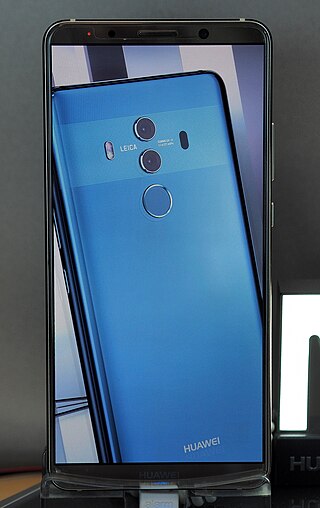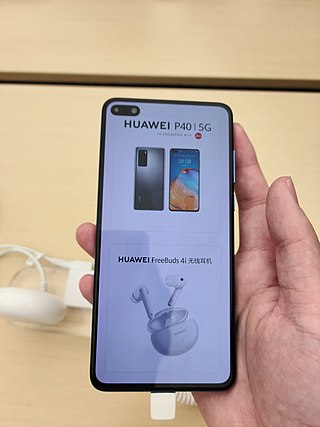
Nexus 6P is an Android smartphone developed and marketed by Google and manufactured by Huawei. It succeeded the Nexus 6 as the flagship device of the Nexus line of Android devices by Google. Officially unveiled on 29 September 2015 along with the Nexus 5X at the Google Nexus 2015 press event held in San Francisco, it was made available for pre-order on the same day in United States, United Kingdom, Ireland, and Japan.

The Honor 8 is a smartphone made by Huawei under their Honor sub-brand. It is a successor of the Huawei Honor 7 within the Huawei Honor series.
The Huawei Nova and Huawei Nova Plus are mid-range smartphones manufactured by Huawei. They were announced and released at the Internationale Funkausstellung Berlin (IFA) on Sept. 1, 2016.
The Huawei Mate 9 is a high-end Android smartphone, designed and produced by Huawei as part of the Huawei Mate series. It was released on 3 November 2016. It was succeeded by the Huawei Mate 10 series, and later the Huawei Mate 20 series.

The Huawei P10 is an Android phablet smartphone manufactured by Huawei. Announced at Mobile World Congress 2017 on 26 February 2017, the P10 is the successor to the Huawei P9 and was succeeded by the Huawei P20 in 2018.

The Huawei Mate 10, Huawei Mate 10 Pro and Huawei Mate 10 Lite are Android smartphones designed and marketed by Huawei as part of the Huawei Mate series. There is also a Mate 10 Porsche design, which has 256Gb of storage but is otherwise identical to the Mate 10 Pro. They were first released on 16 October 2017. Versus the predecessor Mate 9, the Mate 10 pro flagship phone has a faster processor with an integrated neural processing unit, a slightly larger OLED screen (6.0") with a taller 18:9 aspect ratio, a significantly longer battery life and a glass back construction. Chinese and international models are available in dual SIM configuration. It comes with Android 8 and a newer version of Huawei's EMUI interface. All Mate 10 models are unlocked and GSM only. Huawei phones, including the Mate series, are not sold or financed through U.S. carriers due to pressure from U.S. intelligence agencies, though they are available from independent and online retailers.

Huawei P20 and Huawei P20 Pro are Android smartphones manufactured by Huawei. Unveiled 27 March 2018, they succeed the Huawei P10 in the company's P series line.

The HTC U12+ is an Android smartphone manufactured and sold by HTC as part of the HTC U series. It was announced on 23 May 2018 and succeeds the HTC U11 and HTC U11+ smartphones.
The OnePlus 6T is an Android-based smartphone from OnePlus. It was announced on October 29, 2018, before being released on November 6. The launch was originally scheduled for October 30, but was rescheduled to avoid coinciding with Apple Inc.'s on the same day.

The Huawei P series is a line of high-end and medium-range HarmonyOS smartphones produced by Huawei. The P series was formerly marketed as part of Huawei's larger Ascend brand. Some models are called P smart.

A foldable smartphone is a smartphone with a folding form factor. It is reminiscent of the clamshell design of many earlier feature phones. Some variants of the concept use multiple touchscreen panels on a hinge, while other designs utilise a flexible display. Concepts of such devices date back as early as Nokia's "Morph" concept in 2008, and a concept presented by Samsung Electronics in 2013, while the first commercially available folding smartphones with OLED displays began to emerge in November 2018.

The Huawei Mate X is an Android-based high end foldable smartphone produced by Huawei. It was unveiled at MWC 2019 on 25 February 2019 and was originally scheduled to launch in June 2019, but the launch was pushed back to allow for extensive testing in light of the failures reported by users of a similar product, the Galaxy Fold from Samsung. The Mate X launched in China only in November 2019. Huawei announced the Mate Xs on 24 February 2020 as a hardware revision of the original Mate X; it was released in "global markets" outside China in March 2020. The device features a more durable display, improved hinge function and a redesigned cooling system, as well as the newer Kirin 990 5G SoC and Android 10 with EMUI 10.

Huawei P30 is a line of Android-based smartphones manufactured by Huawei. Unveiled on 26 March 2019, they succeed the Huawei P20 in the company's P series line.

The Honor 20 is a smartphone made by Huawei under their Honor sub-brand. It is a successor of the Huawei Honor 10 within the Huawei Honor series.

The Honor 8x is a smartphone made by Huawei under their Honor sub-brand. It is a successor of the Huawei Honor 7x within the Huawei Honor series.

Huawei Mate 30 is a line of Android-based phablets manufactured by Huawei as part of its Huawei Mate series, and the successor to the Mate 20. The Mate 30 comprises the Mate 30/5G, Mate 30 Pro/5G, and Mate 30 RS Porsche Design, which were unveiled on 19 September 2019 in Munich, Germany.
The 2019Motorola Razr is an Android foldable smartphone produced by Motorola Mobility. Unveiled on November 14, 2019, it was released on February 6, 2020. The device is designed to be reminiscent of the original Motorola Razr feature phone series and features a horizontally foldable screen. An updated version of the phone, Motorola Razr 5G, was announced on September 9, 2020, and released on September 15 of that year.

Huawei P40 is a line of high-end Android-based smartphones manufactured by Huawei. Unveiled on 26 March 2020, they succeed the Huawei P30 in the company's P series line.

The Huawei MatePad Pro is an Android-based tablet designed and marketed by Huawei as part of their Huawei Mate series. It was announced on November 25, 2019 and was released on December 12, 2019.

The Huawei P50 and P50 Pro are HarmonyOS-based high-end smartphones manufactured by Huawei. Unveiled on 21 July 2021, they succeed the Huawei P40 in the P series. In March 2023 Huawei released their successor Huawei P60 Series phones in China, and in May 2023 it released the Huawei P60 Pro in Europe.
















